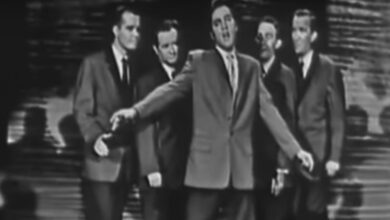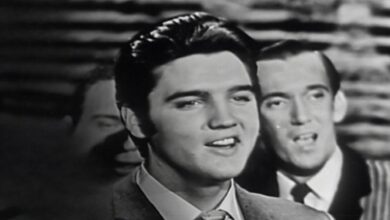This Song Fills Me With Chills Every Time, Elvis Was Unparalleled – Rest In Peace King
Elvis Presley’s rendition of “Green Green Grass of Home” showcases his ability to bring deep emotion and soul to every song he touched. Originally written by Curly Putman and popularized by Tom Jones in 1966, this song tells a poignant story of a man reflecting on his return to his hometown, only to reveal in a twist that he is dreaming from a prison cell. Elvis recorded his version in 1975, bringing his unique vocal style and heartfelt delivery to the country classic.
Elvis’s interpretation of “Green Green Grass of Home” is marked by his rich, resonant voice, which adds a layer of depth and melancholy to the song’s narrative. His ability to convey the protagonist’s longing and regret is palpable, making his version stand out among other renditions. The arrangement features lush instrumentation, with a prominent piano, gentle guitar strumming, and background harmonies that enhance the emotional impact of the lyrics.
Recorded during the sessions for the album “Elvis Today,” Elvis’s version of “Green Green Grass of Home” demonstrates his continued connection to country music, a genre that significantly influenced his early career. The song fits seamlessly within the album’s mix of contemporary country and rock tracks, highlighting Elvis’s versatility as a performer. His deep understanding of country music’s storytelling tradition is evident in his emotive delivery and nuanced phrasing.
Elvis Presley, born on January 8, 1935, in Tupelo, Mississippi, rose from humble beginnings to become one of the most iconic figures in music history. His early exposure to gospel music in church and the diverse musical influences of Memphis, Tennessee, where he moved as a teenager, shaped his distinctive sound. Combining elements of country, blues, and gospel, Elvis created a new genre that would come to be known as rock and roll.
After signing with Sun Records in 1954, Elvis quickly gained popularity with hits like “That’s All Right” and “Blue Moon of Kentucky.” His energetic performances, unique vocal style, and charismatic stage presence captivated audiences. In 1955, he signed with RCA Victor, and his career skyrocketed with the release of “Heartbreak Hotel” in 1956. The following years saw a string of successful hits, including “Hound Dog,” “Don’t Be Cruel,” and “Love Me Tender.”
Throughout his career, Elvis maintained a strong connection to country music, often incorporating it into his repertoire. His love for the genre is evident in his recordings of songs like “Green Green Grass of Home,” which allow him to explore themes of home, loss, and nostalgia. These recordings showcase his ability to interpret a wide range of musical styles while maintaining his unique sound.
Elvis’s influence on popular music and culture extends far beyond his vocal talent. He was a pioneer in the integration of different musical genres, breaking racial barriers in the music industry and paving the way for future artists. His impact on fashion, film, and entertainment further solidified his status as a cultural icon. Elvis’s legacy continues to inspire musicians and fans around the world, cementing his place as the “King of Rock and Roll.”
“Green Green Grass of Home” remains a poignant example of Elvis’s ability to connect with a song’s emotional core and convey its story with authenticity. His version of the song resonates with listeners, reminding them of his unparalleled talent and the depth of his musical artistry. As fans revisit his recording of “Green Green Grass of Home,” they are reminded of the enduring power of Elvis’s music and the timeless appeal of his voice.
Elvis’s rendition of “Green Green Grass of Home” is a testament to his versatility and his deep connection to the music he loved. Whether singing rock and roll, gospel, or country, Elvis brought a unique blend of passion and skill to every performance. His interpretation of this classic song continues to captivate audiences, ensuring that his legacy as one of the greatest performers in music history lives on.



